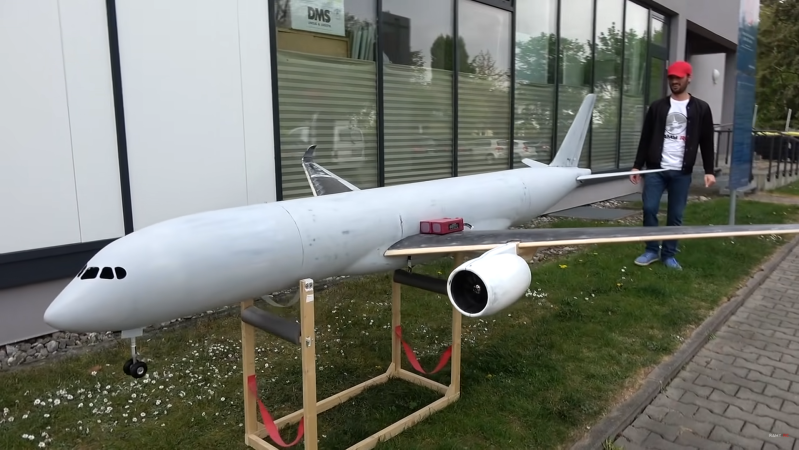Large scale RC aircraft are pleasure to see on the ground and in the air, but putting in the months of effort required to build them requires special dedication. Especially since there is a real possibility it could end up in pieces on the ground at some point. [Ramy RC] is one of those dedicated craftsman, and he has a thing for RC airliners. His latest project is a large Airbus A350, and the painstaking build process is something to behold.
The outer skin of the aircraft is mostly carbon fibre, with wood internal framing to keep everything rigid. The fuselage and winglets are moulded using 3D printed moulds. These were printed in pieces on a large format 3D printer, and painstakingly glued together and prepared to give a perfect surface finish. The wing surfaces are moulded in flat section and then glued onto the frames. [Ramy RC]’s attention to detail is excellent, making all the control surfaces close as possible to the real thing, and retractable landing gear with servo actuated hatches. Thrust comes from a pair of powerful EDF motors, housed in carbon fibre nacelles.
This project has been in the works for almost 5 months so far and it looks spectacular. We’re looking forward to the first flight, and will be holding thumbs that is remains in one piece for a long time. See the video after the break for final assembly of this beast.
For the next step up from RC aircraft, you can always build your own full size aircraft in your basement. If you have very very deep pockets, get yourself a private hangar/workshop and build a turbine powered bush plane.
Thanks for the tip [tayken]!
















Gorgeous! Humbling to think of the man-hours that went into all the casting forms. He had do build that plane twice to get it once.
Thought you could get a certificate for large models, or did that all stop with the drone laws the other year?
Interesting – at what point does it cease to become a “large RC model” and becomes a “small drone/plane”
It was weight based, my memoryphone wires got tangled in my mental pocket though, so not sure which was for which country, somewhere had around 7 kilos. In practice I recall, that meant some scale single engine light aircraft, could be modelled at 1/4 scale and just get under the limit, while others being a little larger or more complex of structure needed certifying.
Anyway, current US regs it seems to have to be a lot bigger than that, starts at 55lb/25kg ….
https://www.modelaircraft.org/sites/default/files/documents/520-A.pdf
Seriously, I’ve got an idea for a two rotor project, something like an Osprey but I don’t know if it would be considered a drone, or an R/C helicopter, or R/C plane. I can’t finf a straight answer.
Well if you want to do it as a cool concept of what an Osprey replacement might look like, and flying it for fun over an empty field, it’s a model. If you’re building it as a useful platform for doing some stuff with, it’s a drone.
Impressive to say the least
Very impressive. But in my opinion it is totally ruined by the lack of real turbojet engines. Putting mockups with electric motors in a build like this is downright blasphemy.
I’m sure he’ll accept the kind sponsorship of two turbojets ;)
Link to your build…
Turbofan, not turbojet
A man of culture :)
It would appear he may live in Europe somewhere, but if not He could always do the true American thing and tell the government to shove and fly it anyway since something that big needs to be flown out in the boonies where johnny law doesn’t give a damn.
He lives in Germany, I saw in one of his flying videos he people were speaking German and he said it was in Germany.
Congrstulatios for your fantastic work and skills. Regards from Barcelona, Spain. Hope to see more videos of this project!
That is truly amazing